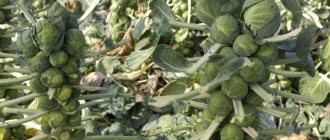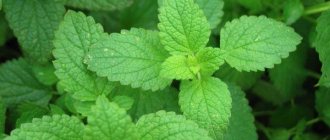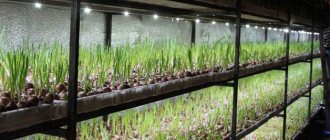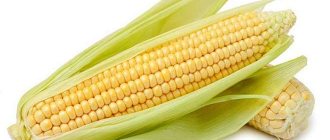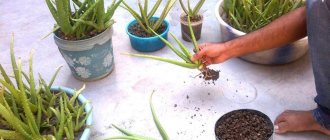Related Posts
- How to remove lice and nits at home
- House dust mite or dust mite: photo, why parasites are dangerous for humans and how to get rid of them
- Review of popular drugs against the Colorado potato beetle
A gardener has many enemies - pests that cause damage to his cherished beds. However, according to unanimous opinion, aphids cause the most trouble for garden crops during the warm season. It is one of the first to attack cabbage and other cruciferous vegetables. The big problem is that aphids on cabbage are multiplying at a “Stakhanov” rate – how should we treat the plants to neutralize this threat?
Cabbage does not develop - it is infected with aphids
Cabbage aphid: description
The dangerous pest belongs to the order Homoptera and appears in late spring. The habitat is the underside of the cabbage leaf. An insect can be recognized by several signs:
- insect no more than 4 mm in length;
- there are small brown antennae on the head;
- With the help of their mouth, the aphid bites into the cabbage leaves and sucks out the juice;
- on the body segment there are torn transverse stripes of brown color;
- green conical tail;
- brown legs;
- lays black, oval-shaped eggs;
- The color of the body is pale green, there is a waxy coating.
Brassicae (aphids) reproduce quickly on cabbage. In one season, 15-20 generations of aphids are replaced. One female lays 40–50 larvae.
In the warm season, only females are born, and males are born in the fall, as they winter well. The females themselves become fertilized.
How to protect cabbage
Due to the fact that cabbage is a crop for the protection of which the use of chemicals is unacceptable, it is advisable to get rid of aphids on cabbage using folk remedies. After all, it is almost impossible to wash off the remnants of the chemical from a tightly curled head of cabbage. This is how it will end up on the kitchen table.
Important!
You can treat cabbage leaves with chemicals only before the head is curled. In the middle or end of spring, during the mass emergence of seedlings, you can spray the cabbage and soil with celandine powder, naphthalene or dust.
You can also use the following brands for this: Aktara, Decis or Aktellik. Any composition is diluted with water in a ratio of 20 ml of product per 10 liters of liquid. The working solution should be sprayed onto the cabbage every 3-5 days. At the very latest period, cabbage is protected from aphids using biological, folk and physical methods. They are described in more detail below.
Why are cabbage aphids harmful?
The insect feeds on the juice of the vegetable crop, causing irreparable damage to the plant. If the pest is not detected in time, there is a risk of losing half the harvest. Types of aphid pests:
- When an insect sucks the juice from the cabbage, the plant stops developing. The leaves curl and dry out. The losses can be huge.
- On its abdomen, aphids carry viruses, bacteria and fungi. As a result, the vegetable becomes sick. Gray rot, black skin or mucous bacteriosis may appear on the surface.
- When the pest absorbs the juice, it produces a sweet liquid that attracts ants. Therefore, these two types of insects are always together. Ants are considered a reliable guard for aphids. They protect offspring from predatory insects and can drag eggs onto other vegetable crops, spreading aphids.
Note! Pest control needs to be comprehensive. They destroy not only the aphids themselves, but also eggs and ants.
Description of aphids and harm
The cabbage aphid is an insect with translucent wings and a long, small proboscis (body length is only 6-7 millimeters). Its body is colored yellow-green, it blends in with the cabbage leaves, so it’s not that easy to spot the aphids. The insect feeds on sap - it pierces a leaf through its proboscis and sucks the sap out of it.
During the active period (spring and early summer), the female lays eggs on cabbage leaves.
The eggs tolerate cold well and overwinter quietly; in the spring, infection of vegetables begins. On a note!
Each female is capable of laying 40 eggs.
The damage from aphids can be colossal. First of all, this is a decrease in the quality of the crop - the cabbage begins to wither and dry out. In addition, aphids are considered carriers of many diseases: late blight, powdery mildew and others. Along with aphids, ants often come to the garden (they are attracted by the sweet smell of insects), which complicates treatment significantly.
How to detect insects on cabbage
Experienced summer residents carefully inspect their vegetable crops every day in order to act promptly when diseases or pests appear. Signs of insects:
- The leaves lose their color and the top becomes colorless.
- Dry areas appear on the surface between the veins.
- The leaves become covered with yellow spots and dry out.
- The vegetable stops growing and loses vitality.
- Aphids can be detected by their dirty coating.
- If a large number of pests have accumulated, the tops curl into a tube and the head does not form.
- A colony of living insects is very visible even without magnifiers, such as a magnifying glass.
Note! When inspecting a plant, you need to bend down and check not only the upper, but also the lower leaves.
Cabbage whites
A diurnal butterfly with white wings and black spots on them. Cabbage larvae are greenish-yellow in color with short hairs and black dots on the sides. It is the caterpillars that cause significant damage to the crop. In addition, they can harm people. The secretion from the poisonous glands causes skin irritation.
Effective measures to protect against cabbage worms are:
- weed control;
- inspection of cabbage leaves and removal of oviposition;
- manual collection of hatched caterpillars;
- biological products (Lepidocid, Bitoxibacillin);
- chemical insecticides (Calypso, Karate Zeon).
Experienced white grass fighters advise building a simple device on your site. Two sticks are stuck into the ground at both ends of the bed with cruciferous crops. A cord is tied to them. And on it, with a distance of 10-15 cm, ribbons-bows (from a regular white bag) are tied. Under gusts of wind, the bows spin and prevent butterflies from landing on vegetables.
Control measures for how to treat cabbage
If there are few aphids on the leaves, you can simply destroy the insects by hand. Take them and crush them. Before processing a vegetable crop, choose the method wisely. If there is a large concentration of the pest, the mechanical method is not effective, so it is better to use chemical, biological or traditional methods.
Chemicals
Insecticides are a reliable way to kill aphids. Vegetable crops are sprayed with chemicals. Experienced gardeners recommend doing this in June. Most summer residents choose the following means:
- Accord - has a contact-intestinal effect. Blocks insect sodium channels. Paralysis of the nervous system occurs and the pest dies. The drug begins to act within 15-30 minutes after spraying. Protects the plant from the appearance of new individuals for 7 days. Spray cabbage during the growing season. The procedure is repeated 2 times per season.
- BI-58 is an organophosphorus compound, sold in bottles with a capacity of 1–20 liters. The drug is white or dark blue. After processing, the active substances enter the plant fibers. The aphid, sucking the cabbage juice, receives a lethal dose of the drug and dies. Death occurs due to paralysis. Dilute the product 1 ml per liter of liquid.
- Delight - you can use the product in dry and hot weather. When a pest enters the body, it disrupts the functioning of the nervous system and causes paralysis. The aphid dies. The effect period begins in a day. The vegetable crop will be protected for 2–3 weeks.
- Ditox - unlike other drugs, the effect is immediate. Has a detrimental effect on the nervous and cardiac systems. Paralysis and death ensues. The product begins to act within 3–5 hours. The protection period is 14 days.
- Deltamethrin - kills aphids almost immediately. The drug is harmless to humans. The protection is valid for 20 days.
- Decis - the product has a weak odor, is highly effective and does not accumulate in the soil at a small dose. A solution for spraying cabbage is prepared from 0.5 g of the drug and 5 liters of water.
- Spark - the package may have the prefix “Bio” or “Golden”. The product is sold in liquid, powder or tablet form. The product is pre-dissolved in water. Protection lasts 3 weeks. To consolidate the effect, repeat spraying is done after 15 days. Treatment is carried out once a month, but the last one should not be earlier than 20 days before harvesting the cabbage.
- Inta-vir is an inexpensive but effective product that helps save up to 90% of the crop, there is no smell or color. After spraying, the drug continues to act for 30 days. Once ingested by aphids, it destroys the nervous system. But Inta-vir has one drawback - it does not have an effect on larvae, but only on adults. After rain, the solution is washed off.
- Kalash - long-term protection, the product is effective and at low consumption. Not only adult pests die after treatment, but also larvae. The action takes place within a day. The cabbage will be reliably protected for 2 weeks.
- Karbofos is a toxic substance that affects both larvae and adults. The insecticide is diluted in water 7.5 g per 5 liters of liquid. During processing, be sure to wear gloves and a respirator. One application is enough. All pests will die within 2 hours. The protection will last 20 days.
- Corado is an effective remedy; all pests die after treatment. The protective barrier lasts 3–4 weeks. Complete death of the aphids occurs within 2-3 days.
- Lasso - death of insects occurs within the first hours after use. The insecticide is inexpensive. After treatment, aphids' feeding activity decreases. Protection lasts up to several weeks.
- Rovikurt is a dark liquid. Gardeners recommend using it on young cabbage. The result after use is excellent and lasts for several days.
- Safefos - spray the leaves with the composition immediately after transplanting to a new place. Dilute 5 g per 5 liters of water. The aphids will disappear after treatment after 3 days.
Biological agents
When answering the question of how to fight insects, they spray aphids with biological preparations. The following types are suitable:
- agravertine - affects the intestinal system of the insect, causing paralysis and death;
- admiral - the growth and development of the pest slows down;
- akarin - all insects will die in 8 hours;
- actofite - affects the functioning of the nervous system.
Traditional methods
Not all gardeners like to use insecticides, but prefer natural remedies.
Note! Traditional methods are best used before harvesting, this way you can protect yourself and your family from chemicals.
Tobacco
Aphids cannot tolerate the smell of the plant. You can plant it near cabbage or prepare a decoction or infusion. The recipe is simple:
- you need to buy or dry 200 g of tobacco leaves;
- pour 5 liters of water;
- cook the broth over low heat for 90 minutes;
- let the drink cool;
- add as much liquid as has boiled away.
Cabbage leaves are sprayed with the prepared broth, the entire surface should be wet. The treatment is repeated once a week.
You can prepare a tobacco infusion to kill the pest. Buy or make your own 200 g of shag. Fill everything with 5 liters of hot water. Soap is added to make the solution stick to the leaves. The container is closed, the mixture is infused for 2 days.
Water with the prepared solution every week. It is necessary to process not only the upper leaves, but also the lower ones.
Vinegar
The table species has a very pungent and sour smell; pests cannot stand it and leave the garden. It is better not to use pure vinegar. Make the following composition:
- pour water into a bucket;
- add 190 ml of substance;
- pour in 35 g of any liquid soap;
- I mix the solution.
Note! This method is suitable for processing only on open ground.
Ammonia
The composition has a no less pungent odor than vinegar. There is an opportunity to get rid of both the young and adult generations. You need to prepare a solution of 10 liters of water, 50 ml of ammonia and 100 g of laundry soap. All ingredients are mixed. The soap is pre-crushed. The composition for processing should be uniform in consistency.
Vegetable crops are treated 2 times every 30 days. If done more often, the leaves may become deformed.
Ash with spices
Red pepper is best as an additive. To get rid of aphids, prepare the composition according to the following recipe:
- a glass of ash is poured into a bucket and filled with water;
- add 3 tbsp to the solution. crushed soap;
- add 1 tbsp. l. ground red pepper;
- mix everything and leave for a day.
You can spray once a week until all insects disappear. Cinnamon is often used instead of pepper.
Tar soap
Using a solution based on the ingredient, you can not only get rid of the pest, but also disinfect the vegetable. Soap 100 g is dissolved in 10 liters of water. The composition is mixed well. Pour the resulting liquid into a sprayer and spray it over all the leaves.
Tomato and potato tops
An infusion is made from the components. Take vegetable tops and pour boiling water over them. Infuse the solution for 3 days. Before use, the composition is filtered. The resulting product can be sprayed on cabbage 2 times a week.
Yarrow
A decoction is prepared from the plant according to the following recipe:
- 200 g of dried or 400 g of fresh herbs are crushed;
- put in a saucepan and fill with a liter of water;
- the mixture is boiled;
- the composition is filtered and cooled.
The solution is not used in its pure form, but is diluted 1:10.
Garlic
The vegetable has a pungent odor, so it is suitable for treatment against aphids. The solution is prepared from unpeeled garlic cloves (800g). The vegetable is placed in a pan and filled with water (10 l). The mixture is brought to a boil and left for another 2 hours over low heat. The resulting broth is filtered and cooled.
Before spraying, the broth is diluted with liquid 1:1.
Bay leaf
The plant is rich in essential oils, the aroma of which is not tolerated by aphids. A decoction is prepared on its basis. 10 g of dry leaves are poured with one liter of hot water. Leave for one hour and cool. The bay leaf is removed from the solution.
The composition is poured into a suitable container and the vegetable crop is processed.
Soda
A mixture for killing aphids is prepared from soap and baking soda:
- pour a tablespoon of the ingredient into 10 liters of water;
- crushed laundry soap is added to the solution;
- All components are mixed well to obtain a homogeneous mass.
Milk and iodine
A solution for treating leaves is prepared from 100 ml of milk of any fat content and 30 drops of iodine. The mixture is stirred and a liter of water at room temperature is added. All components are mixed.
The resulting mixture is sprayed onto the vegetable; the aphids will disappear in 1-2 weeks.
Coca Cola
The drink is diluted with water and the leaves are treated. No wonder this drink is considered harmful. The mixture ratio is 1:1.
Celandine
The plant is most often used medicinally, but is also often used for pest control. Recipe for preparing the composition:
- 4 kg of fresh green celandine or 1 kg of dry grass are poured with 10 liters of warm water;
- insist for a day;
- filter and pour in 35 g liquid soap.
Mustard
It is used in powder form. 50 g of the substance is dissolved in 5 liters of water. After the mustard has dissolved, they immediately move on to processing the cabbage.
Vodka
The hot drink is used against pests. To prevent alcohol from burning the leaves, you must first make a solution with water, maintaining a 1:1 ratio.
Green soap
Heat a liter of water and dissolve 100 g of the substance in boiling water. The resulting mixture is further diluted with 9 liters of liquid. Use strictly for its intended purpose.
Birch tar
The composition has an oily, viscous substance and a pungent odor. Birch tar 15 g is dissolved in 10 liters of water. Additionally add 45 g of laundry soap. The resulting solution is thoroughly mixed until it becomes homogeneous.
Note! You need to spray the composition in the evening.
Boric acid
It has no taste or smell, but when it enters the stomach it causes muscle paralysis. Used in two versions: dry and aqueous solution.
- The first method: sprinkle it where aphids were found. The substance also gets rid of ants.
- Second method: a packet of acid is dissolved in 10 liters of water. The composition is sprayed not only on cabbage leaves, but also on anthills.
Natural enemies of aphids
Birds and some types of insects will help get rid of the pest. Tits mainly feed on pests. Gardeners hang feeders around the perimeter of the site to attract birds.
The ladybug will also get rid of aphids. To increase the number of insects, it is enough to install log houses in the garden.
Cabbage moth
One of the varieties of butterflies that can cause colossal damage to the cabbage crop. Distributed everywhere. Dimensions do not exceed 1.5 cm, brownish-brown color. It has a peculiar pattern on the wings in the form of a light, unevenly thickened stripe. Very prolific and migrates long distances. All over the world it is considered one of the most important pests of cabbage and other cruciferous crops.
Adults are active at dusk and at night. Eggs are laid on the underside of cabbage leaves. The larvae, having hatched from the eggs, make passages inside the leaf tissues, moving along the main veins. Coming to the surface, dark green caterpillars settle on the plant, putting on a cocoon.
During their development, caterpillars undergo 3-4 molts. All this time they actively feed on cruciferous crops. Subsequently, pupae are formed that are able to tolerate low temperatures. At this stage of transformation, the moth overwinters, and in the spring of next year the cycle starts again.
In the fight against cabbage moths, preventive measures are important: eliminating weeds and residues of cruciferous crops.
Methods for killing moths:
- Installing light traps in garden beds. You will need a regular lamp and a white saucer with oil. The distance between the lampshade and the saucer should be no more than 10-15 cm. The direction of light is vertical. At night, moths flock to the light and fall into the vegetable oil.
- Folk remedies (ash-soap solution, infusion of wormwood or celandine).
- Insecticides. They use herbal (tobacco-based), biological (Entobacterin, Lepidocide, Bactospein) and chemical preparations (Ripcord, Ambush, Talkord).
Attention! Cabbage moths develop resistance to insecticides over time.
Prevention
In order not to choose methods of insect control, it is necessary to carry out preventive measures in a timely manner. You need to proceed as follows:
- Aphid eggs survive winter in leaves, so you need to remove all tops from the area and take them out.
- If there are plants with massive pest infestation, it is better to burn them and dig up the soil itself to 22 cm.
- It is necessary to clear not only the garden itself of old tops, but also the entire surrounding area.
- You can plant tobacco or herbs next to the cabbage. The pungent odor will repel pests.
- It is necessary to carry out all technological measures on time. Aphids damage damaged leaves first.
- It is worth planting cabbage where onions, beans or carrots used to grow.
Cruciferous flea beetle
This is exactly the case when size doesn't matter. With a body length of 2-3 mm, the flea beetle is a very serious pest. At the end of April, insects leave their wintering grounds and gain strength on weeds in anticipation of their favorite delicacy - cruciferous plants (cabbage, radishes, rutabaga).
Young cabbage leaves are especially vulnerable. Tiny bugs are capable of riddling seedlings in one day. Small aggressors bite into a delicate plant, leaving behind many depressions or through holes. And the beetle larvae eat the roots at this time.
Flea beetles are especially active in hot and dry weather. It’s not hard to guess that after such “treatment” you shouldn’t even dream of a good cabbage harvest.
Therefore, there is no need to wait for pests to appear. Focus all your efforts on preventing the invasion.
- Choose early varieties of cabbage (planting in early April) or late varieties (in July). Plants have time to grow and harden sufficiently to lose their food attractiveness to insects.
- Weed control. A simple measure that will deprive fleas of their habitat.
- Abundant watering. Fleas do not tolerate dampness well.
- Phytoncidal plants (dill, garlic or coriander). The specificity of their aroma is not to the liking of cabbage pests.
- Shelter of young shoots. Agrospan or a similar covering material will help protect against flea beetles until the crop gets stronger.
Effective methods of control are:
- Dusting cabbage leaves (wood ash, tobacco dust, ground pepper).
- Spraying with homemade infusions (tops of tomatoes, potatoes, garlic, wormwood and other popular folk remedies).
- Chemicals (Decis, BI-58, Imidalit, Iskra DE).
Attention! When using chemical insecticides, it is important to adhere to the specified frequency of application. Otherwise, the effectiveness of the measures taken will be significantly reduced.
Cabbage varieties that are resistant to pests
Breeders are constantly working to create new varieties that are resistant to aphids. Over the years, several types have been created:
- Aggressor - was developed in the Netherlands. The cabbage variety is late-ripening and white. The yield is high and has excellent resistance to frost in the spring. Aphids and other pests are not interested in vegetables.
- Amager 611 is a late type of cabbage that is in great demand among gardeners. The vegetable crop is resistant not only to the pest, but also to many diseases. Heads of cabbage are stored for a long time.
- Bartolo is a late, high-quality variety, bred in the Netherlands. Cabbage rarely suffers from fusarium and clubroot. Pests do not attack as often as other varieties.
- Snow White - the vegetable ripens late, the heads of cabbage are flat, which are stored for six months. Aphids are not interested in this type of vegetable.
- Ramkilla is a late variety of cabbage, can be stored for a long time, and is resistant to pests.
Cabbage scoop
Refers to polyphagous pests. But if there is a choice, he will give preference to cruciferous plants. The armyworm is active in the evening and at night. Moths are colored grayish-brown. The color of the caterpillars varies from gray-green to dark brown (almost black). There are yellow stripes on the sides.
The larvae feed on leaves during the night. At the final stage of their development, cutworm caterpillars are able to eat the entire leaf, leaving only large veins. And then they penetrate deep into the head of cabbage, making winding passages.
Attention! The cutworm is a moisture-loving pest. Most often found in areas with high humidity and moderate temperatures.
You can resist the invasion of the aggressor using the following methods:
- timely removal of weeds;
- loosening the soil to destroy clutches of eggs and larvae;
- early planting of seedlings;
- planting plants that smell unpleasant to insects (marigolds, calendula, garlic, onions) between cabbage heads;
- treatment with herbal infusions (wormwood, tansy, mint);
- dusting with tobacco dust (the material can be a tobacco smoke bomb after it has been used in a greenhouse for its intended purpose);
- covering the cabbage with a net with small holes;
- use of drugs (Sherpa, 5% dust, pyrethrum, Decis, Kinmiks);
- biological products (Lepidocid, Fitoverm, Bitoxibacillin);
- bait traps with molasses or jam, which are hung 1 m from the ground.
Useful tips
To grow cabbage in open ground, you need to follow the recommendations from experienced gardeners:
- Water the seedlings with warm water, then the seedlings will be stronger and more resistant to disease.
- It is necessary to feed and pick early cabbage. Seedlings need to be grown at a temperature of 18 degrees during the day and 8 degrees at night. Fertilizing is done after the first 2 leaves appear. Gardeners advise using Zdraven. The next feeding is carried out after 10 days. A liter of mullein is diluted in water and the seedlings are watered.
- To make the vegetable crop resistant to diseases, hardening is carried out. Once a week, water the seedlings with a solution of potassium permanganate. 3 g are diluted in 10 liters of water.
- Before planting cabbage, hardening begins 10 days before planting. Periodic hardening is carried out. Such seedlings will be able to withstand frosts down to -7 degrees.
- It is worth planting seedlings in a sunny area. It must be protected from draft and wind.
- It is better to plant early varieties of cabbage in a place where onions, cucumbers or turnips used to grow, and late-ripening varieties in an area where there was a good potato harvest.
- Before planting seedlings, dig up the soil well; it should be loose. Organic matter or mineral fertilizers are first added to the soil.
- A certain distance must be maintained between the rows: for late varieties - 80 cm, and for early varieties - 45 cm.
- Before planting, add 2 glasses of warm water to each hole, then the root system will not experience a moisture deficiency.
- After planting, the soil is sprinkled with dry soil, and late varieties are planted directly into the soil.
To get a high yield of cabbage, you need to know the rules for planting seedlings and provide regular care for the vegetable crop. You need to water the vegetable properly and constantly monitor its development and growth. If aphids appear on the leaves, then all plants must be treated. First you should try folk remedies, if they don’t help, then start using chemicals. The main thing is to choose the right pest control product.
Signs of appearance and damage caused
If cabbage aphids infest the beds, this is fraught with serious problems, since they are carriers of more than 20 different viruses. Pests suck the juice from the leaves. Plants lag behind in development and become incapable of forming heads. When heavily infested, aphids can cause the death of cabbage crops.
At first, aphids are difficult to notice. The pest prefers the underside of leaf blades. Leaves affected by an aphid colony look rotten on the upper side, significantly lighter than healthy ones, and the edges curl downward. If heads of cabbage are formed, they are small and loose.
Carefully inspect the cabbage: if you find aphids, as well as traces of their vital activity, in particular honeydew (sweet sticky secretions), immediately begin pest control.
Fighting aphids with traditional methods
To combat aphids as effectively and quickly as possible, special preparations with an insecticidal effect are used. They remove pests and their larvae, and also have a wide range of effects. At the same time, it is necessary to strictly observe the dosage and sequence of processing, otherwise chemicals may accumulate in the fruits and other parts of the plant.
The specificity of growing cabbage is that almost the entire above-ground part of the plant is used for food, so the use of insecticides is undesirable and even dangerous.
The waste products of these insects also harm the plant, polluting the surface and interfering with the normal processes of photosynthesis. In addition, large colonies of aphids slowly poison vegetables, making them unedible. Aphids prefer young seedlings and leaves, so strict control is necessary in the early stages of the growing season.
The video shows how to fight aphids using traditional methods:
In addition, it should be taken into account that treatment of plants must be carried out in dry weather and in the evening, when “beneficial” insects have already stopped working. It is necessary to spray the outer side of the leaves well, where insects like to hide, and in case of rain or severe damage, the treatment is repeated every week.
Signs of pest damage
Aphids can appear on cabbage suddenly, and this moment should not be missed. The insect reproduces quickly, so it is very important not to miss the moment of its settling on cabbage. Cabbage plots should be inspected daily, paying special attention to the underside of the leaves.
The following signs indicate that the pest is already nearby:
- cabbage leaves lose their usual color, become brittle, their tops become colorless;
- sections of the leaf between adjacent veins seem to decay and begin to dry out;
- cabbage loses its green color more and more, the leaves become covered with yellow spots and gradually dry out;
- the plant is severely retarded in growth, quickly losing its vitality;
- parasitic insects leave their waste products on the leaves in the form of a sticky, dirty coating;
- with a large number of parasites on one plant, the leaves take on the shape of a tube, are severely deformed, and heads of cabbage do not form;
- If the colony is severely infested, live aphids can be seen on the cabbage with the naked eye.
Attention! When inspecting cabbage plants for aphids, do not be too lazy to bend down as low as possible. These insects first colonize the lowest leaves, and only then gradually climb higher.
Treatment with folk remedies
Folk remedies are necessary to protect early ripening types of cabbage: early, lettuce and leaf cabbage.
Due to the short growing period, early ripening cabbage cannot be sprayed with insecticides. Pest control consists mainly of preventive measures. Kale (plume, pak choi) and Chinese cabbage (petsai) have tender, juicy leaves and attract a large number of leaf-eating and sucking pests. Cruciferous flea beetles and slugs are especially annoying. If these pests get close to a loose head of cabbage, it will be impossible to fight them - they will quickly destroy the plant, from which only perforated leaves will remain.
The plantings are covered with non-woven fabric. This simple technique will help isolate plants from fleas and slugs. Dusting the beds with wood ash immediately after planting the seedlings helps prevent flea beetles.
For aphids and caterpillars, use a soap-ash infusion.
- A tablespoon with a heap of ash is poured with a liter of boiling water.
- Mix well and leave overnight.
- In the morning, filter, add a few drops of liquid soap and spray the plants at 5-6 in the morning, trying to capture the lower part of the leaves.
- Treatment of cabbage against pests is repeated every other day.
If aphids appear on Chinese cabbage, you can prepare a decoction of wood ash:
- sift 300 g of ash;
- to fill with water;
- boil for 20 minutes;
- let it sit;
- strain;
- dilute in 10 liters of water and spray the plants.
This decoction drives away aphids not only from cabbage, but also from any other vegetable and garden crops. Ash will also be useful in the fight against slugs. It is sprinkled on the ground around the plants, creating concentric circles on the surface of the bed. Once wet in the rain, the ash will no longer be a barrier for mollusks, so you need to alternate circles of ash with areas covered with red ground pepper, and at the same time set traps for slugs.
There are a few more tips for protecting white cabbage, cauliflower and any other cabbage.
- To protect the roots from the cabbage fly, you can simply cover the ground near the stems with non-woven material.
- The heads of cabbage are covered with thin non-woven material to protect them from butterflies. If caterpillars do appear on the leaves, you can fight them only with approved insecticides or the “grandmother’s” method - collecting them by hand.
- It is advisable to clear the cabbage of caterpillars in time - before the heads of cabbage begin to curl. Plants damaged by caterpillars are poorly stored and become vulnerable to bacterial diseases.
- A good solution would be to plant strong-smelling plants next to cabbage: tagetis, mint, wormwood.
- Many pests do not like the strong smell of vinegar. To protect cabbage, a tablespoon of vinegar essence is dissolved in 10 liters of warm water and sprayed on the plants on a clear, warm day.
- The specific smell of ammonia cannot be tolerated by the most malicious cabbage pests: aphids, ants, flies, mole crickets, weevils, and slugs. The drug is used to protect plants and at the same time for nitrogen fertilizing. 50 ml of alcohol (1 bottle) is diluted in 10 liters of water and sprayed on the plants from a spray bottle or doused with a watering can.
- Decoctions made from tomato tops, dandelions, wormwood, onion peels, laundry soap, and garlic will help against aphid infestations.
- Spraying the plantings with an infusion of black henbane, datura vulgaris, creeping bittersweet, and a 0.5% solution of Enterobacterin will save you from caterpillars.
- From the second half of July, slugs flock to the garden, for which cabbage is a tasty treat. To protect plants from slugs, you can use a thin covering material or dust the leaves with ash (a glass per square meter). Ash not only prevents uninvited guests from nibbling on vegetables, but also serves as a potassium fertilizer.
Additional Recipes
In addition to those listed above and briefly described, there are a number of additional recipes, some of which are given below.
Soda
You can also remove aphids from cabbage by using a mixture of soda and soap. The recipe is prepared like this:
- dilute 1 tbsp in 10 liters of water. soda ash;
- add half a crushed bar of laundry soap there;
- The composition is thoroughly mixed until homogeneous.
Milk and iodine
Many people know that using a recipe based on milk and iodine successfully fights powdery mildew on vegetable plants, but it turns out that this can also be used to resist an invasion of aphids.
The recipe is prepared like this:
- take 100 ml of milk with low fat content;
- drip 30 drops of iodine into it;
- mix the composition and add 1 liter of raw water to it;
- Mix again and start spraying the cabbage.
Coca Cola
Oddly enough, you can fight aphids by using a popular soft drink. Coca-Cola is diluted half and half with water and the resulting solution is sprayed on cabbage plantings.
Garlic and onion
Vegetable growers who use garlic and onions against aphids speak very flatteringly about this method. Bulbs and peels are suitable for this. The recipe preparation algorithm is as follows:
- 3 heads of onions or 5-6 heads of garlic, without peeling, chop with a knife;
- add 1 liter of water to the onion or garlic mass;
- put the pan on the fire and boil for half an hour;
- filter, add soap, stir;
- used for their intended purpose.
Celandine
The herb celandine is used in medicine for healing from a certain list of diseases. However, it can be used against aphids if you prepare the following recipe:
- 1 kg of dry or 4 kg of green grass pour 10 liters of heated water;
- leave for 23 hours;
- strain and pour in 35 g of liquid soap;
- use as intended.
Mustard
Mustard is also suitable for expelling aphids from cabbage. To do this, 50 g of mustard powder is dissolved in 5 liters of water. Immediately after preparing the recipe, you should start spraying.
Vodka
In households where vodka is not always used for its intended purpose, it can be used in the fight against aphid colonies. In order not to burn the leaves during the spraying process, vodka or moonshine is diluted in half with water.
Read how to fight aphids by spraying with vodka in this article.
Green soap
A solution based on green soap is prepared as follows:
- 100 g of soap are diluted in 1 liter of heated water;
- add another 9 liters of raw water to the composition;
- apply as intended.
Birch tar
You can use birch tar against aphids on cabbage. It has an oily, rather viscous substance and a strong odor.
The simplest recipe is as follows:
- 10 liters of water are poured into the bucket;
- add 15 g of birch tar and 45 g of crushed laundry soap;
- the solution is stirred for a long time until smooth;
- fill the sprayer with it and moisten the cabbage leaves in the evening.
Boric acid
Boric acid is odorless and tasteless. Once in the digestive tract of an insect, it causes muscle paralysis followed by death.
This product can be used against aphids, ants and other insects in two ways:
- Use of the substance in dry form. The powder is sprinkled in those places where ants or aphids have been noticed.
- Using an aqueous solution. To do this, dissolve a bag of boric acid in 10 liters of water. The resulting solution is watered over anthills and sprayed on cabbage.
How to get rid of secretive cabbage pests
Stem cabbage sneaker - Ceutorhynchus quadridens (order Coleoptera, family Weevils). Distributed in the North-Western, Central, Central Black Earth, North Caucasus, Volga regions. A dangerous pest of young cabbage, radish, turnip, radish and rutabaga plants. Beetle 2.5-3.5 mm long; body short oval, black, covered with gray hairs; rostrum thin, long; when at rest, the beetle retracts it under the underside of the body. The antennae and tarsi are reddish. The larva is up to 5 mm long, worm-shaped, legless, slightly curved, whitish, with a yellowish head. The egg is oval, white, 0.5-0.6 mm long. Beetles overwinter in the top layer of soil. In early spring, seedlings are planted in greenhouses and open ground. The beetles gnaw small holes and holes in leaves and stems without causing serious harm. Females lay 2-4 eggs in holes gnawed out in the midrib and petiole of the leaf; Small swellings form in places of deposition. Fertility - 140-280 eggs. The larvae cause damage by eating away the passages in the midrib and petiole of the leaf, often moving into the stem. The larvae develop in 30-35 days. Having finished development, they go into the soil to pupate. Young beetles, after a short additional feeding, go to their wintering grounds. 1 generation develops per year. Severely damaged seedlings turn black and rot. When the petioles are damaged, the leaves break and hang on the stem, but remain green and juicy for some time. Plants lag behind in development and lose productivity.
Protective measures: rejection of damaged seedlings; loosening the row spacing during the period when the larvae enter the soil; compliance with crop rotation; destruction of cruciferous weeds and plant residues. Post-harvest plowing. To get rid of these cabbage pests as quickly as possible, when the number is more than 1 beetle per plant and the infestation is over 20-30%, it is necessary to use recommended insecticides.
Seed (rapeseed) secretive proboscis - Ceutho-rrhynchus assimilis (order Coleoptera, family Weevils). It is found in the same regions as the stem stalker. Pest of seed plantings of vegetable and oilseed cabbage crops. Beetle 2-3.5 mm long; the body is short oval, black in color, covered with short light hairs; rostrum thin, bending. The larva is white with a yellowish or brown head, legless, slightly curved, up to 3-5 mm long. The egg is white, oval, 0.6 mm long. Adult beetles overwinter under plant debris and in the top layer of soil. In spring they feed on weeds and cultivated brassicas, slightly damaging the stems and buds. After additional feeding, the females gnaw out small holes in the pods and place 1 egg in them (less often 2-3). Overall fertility is 120-150 eggs. The larvae eat up the seeds in the pods: one larva destroys up to 10 seeds. The larvae develop in 14-35 days and go to pupate in the soil; The pupal phase lasts about 20 days. The new generation of beetles, which appear in the second half of summer, feed mainly on weeds. 1 generation develops per year.
How to deal with these cabbage pests in your summer cottage?
Protective measures: it is necessary to observe crop rotation with spatial isolation of cabbage seed plantings; weed control; optimally early harvesting with the destruction of plant residues; post-harvest deep plowing. In case of high numbers - treatment with approved insecticides.
Description of the pest
Aphids are small sucking insects that attack many crops, but they are especially partial to cabbage. Adults measure up to 2 mm and are black, gray or dark green in color. They are able to eat a developing fork in a few days.
The female lays many eggs on weeds at the end of September, from which fast-growing larvae hatch in the spring. By mid-summer, adult individuals grow wings and are capable of causing damage to large areas of plantings.
Important! From time to time (for example, weekly) it is necessary to inspect the plants in the garden or field. This will help detect pests in time and prevent their spread.
These insects settle on the lower part of the leaves and can remain unnoticed for a long time, until painful symptoms appear on the plant. Moreover, in the first half of summer, only females are born, and after mid-July, males are also born, fertilizing females to lay offspring for the next spring.
Pests of cabbage seedlings in open ground: cruciferous flea beetle
This insect is one of the most dangerous pests not only for cabbage seedlings, but also for other cabbage crops.
The cruciferous flea flea reaches only three millimeters in length. It overwinters in the soil, foliage or cracks in greenhouse structures. The insects begin their feeding on weeds growing next to the cabbage, and then switch to the seedlings of the crop. The flea beetle can damage cabbage at the very beginning of its development. It chews holes in young leaves, preventing the plant from developing to adulthood.
The cruciferous flea beetle is dangerous because it attacks cabbage and its larvae. The activity of this insect is especially noticeable on hot days. If no measures are taken, in the heat they will destroy the cabbage crop in a matter of days.
To protect cabbage from this pest, you need to get rid of weeds such as rapeseed, shepherd's purse, field grass and others. If the weather is hot, the seedlings are covered with light material such as agril.
You can fight fleas by pollinating with tobacco dust.
Among the chemical preparations, Actellik and Bankol are suitable. The second drug is the safest, as it is based on an annelid worm extract.
Why do aphids appear on cabbage?
Cabbage is a “home” for aphids, since the parasite is born and develops on this vegetable, after which it attacks surrounding plants. But insects return to the cabbage to lay eggs. This is due to the fact that the leaves of the plant are juicy, tasty and contain many useful substances not only for humans, but also for the insects that parasitize on them.
Did you know? The life cycle of aphids is short - during the warm season it can change 20
–
30 generations of parasites.
Cabbage fly
As soon as the soil warms up to +12°C, cabbage flies will begin to fly out. This period coincides with the planting of cabbage seedlings. One female is capable of laying about 150 eggs. The fly selects laying sites in the soil near the root collar of plants.
Attention! The fly does not lay eggs in mulched soil. She is interested in soil with cracks and lumps.
The emerging larvae penetrate the root of the plant and feed here. This destroys soft tissue. And the larva, having made numerous passages, goes deeper into the soil. There she will remain for the winter. Young cabbage with a damaged root system is delayed in development, acquires a bluish-lead tint, and then withers.
Necessary measures:
- preventing the development of cruciferous weeds;
- cleaning of plant residues;
- planting early varieties of cabbage;
- combined plantings with strong-smelling crops (parsley, sage, coriander, celery);
- using infusion of bay leaves;
- dusting with wood ash;
- installing obstacles around plants (cardboard, plastic, other dense materials);
- Dipping the roots before planting the seedlings in a clay mash (the larvae will not be able to reach the soft tissues of the roots).
If flies are nevertheless noticed on the site, it is worth turning to radical measures - the use of insecticides (Karbofos, Bazudin, Aktara, Rovikurt). This will allow, if not completely destroy cabbage pests, to significantly reduce their population.
How to treat cabbage and land for planting
You need to start attacking pests while preparing the beds. In early spring, spill the soil with Bordeaux mixture - this will destroy thrips overwintering in the soil. To fight rodents, lay out poisoned bait; any sanitary service will sell you bags of deadly treats for rats and mice. You can move a cat from a city apartment to your dacha for the summer. Just keep in mind that some pets have forgotten how to hunt rodents and can, while basking in the sun, watch with interest how a mouse eats your plantings. In addition, pets can eat poison or a poisoned rat and die.
Many gardeners use chemicals to control pests; the whole family eats their crops in huge quantities and feels great. You should not be afraid of poisons, because the developers have provided safety measures for people. Carefully read the instructions for each product and follow its recommendations exactly. The dangerous poisons that cabbage absorbs decompose after some time and turn into harmless compounds. If you do not exceed the dosage and do not spray the forks before harvesting, you will get a healthy and safe harvest.
To protect against pests you can use:
- "Aktaru";
- "Fury";
- "Bankol."
Why are aphids dangerous?
The danger of aphids for cabbage lies in the fact that it multiplies quickly, sucks the vital juices from the crop and provokes disruptions in its vital functions, which is why the vegetable develops poorly and dies.
In addition, aphids can infect the plant with various fungal and viral diseases, including:
- mosaic;
- black ring spot;
- necrotic jaundice, etc.
The fact is that aphids are capable of transmitting various diseases from diseased plants to healthy ones. So, if there is a diseased plant in the garden, colonies of insects will quickly spread pathogenic microflora, so other garden plants growing in the neighborhood will also suffer.
Review of effective drugs
If using treatment at home with folk remedies can mainly only achieve the expulsion of aphids from cabbage beds, then through the use of professional purchased preparations people achieve their complete extermination. To achieve even better results, it is recommended to alternate chemical agents.
Fitoverm
Among biological products, Fitoverm should be especially noted. With its help, they successfully fight against various parasitic insects.
A solution is used against aphids on cabbage, which is obtained from a liquid concentrate of this substance and water in a ratio of 4:1000. For each hundred square meters, 400 ml of working solution is used.
Spark
An insecticide such as Iskra has long gained popularity among gardeners due to its high efficiency. It can be purchased at retail outlets in the form of a liquid concentrate, tablets or powder.
The drug Iskra for aphids, instructions for use, read this article
On the day of spraying, prepare the solution according to the instructions. The protective effect lasts about 20 days. During this period, adult insects and caterpillars of any age die.
Attention! To completely exterminate insects, treatment should be repeated after 14 days. At least 20 days should pass from the last spraying to harvesting the heads of cabbage.
Tanrek
This insecticide belongs to the group of enteric contact agents. Once on the integumentary membrane or in the intestinal tract of the insect, the chemical blocks nerve impulses, causing rapid death. Tanrek's water-soluble concentrate is available in the form of ampoules, bottles or canisters.
To kill aphids on cabbage by spraying, dissolve 5 ml of the chemical in 10 liters of water.
Aktara
This is a fairly new liquid insecticide, but has already proven itself. Against aphids, this is one of the most popular remedies, and one treatment is almost always enough to exterminate the parasite. The product penetrates the plant tissue 2 hours after treatment. Together with the juice, the poison enters the insect's body, causing paralysis and inevitable death.
In order to kill aphids, it is enough to dilute 2 g of the drug in 10 liters of water. The work is carried out by spraying.
Deltamethrin
It is classified as a broad-spectrum insecticide. After its use, aphids, fleas, and caterpillars of various butterflies die from paralysis. Due to the content of only natural components, it is absolutely harmless to animals and humans.
The effect of the chemical begins immediately and lasts for 3 weeks.
Attention! Based on this product, our industry produces popular drugs: Fas, Decis, Atom.
Pyrethrum
This is a preparation of biological properties, the action of which is based on a special compound isolated from chamomile. The product is harmless to culture and warm-blooded creatures. It only kills aphids.
On the day of treatment, 60 g of pyrethrum are dissolved in 10 liters of water. Treatments can be carried out 2 times a month throughout the warm period of the year.
Karbofos
This chemical has been tested by time. Vegetable growers have been using it for a long time when cabbage and rapeseed are severely infested by aphids. An organophosphate insecticide effectively kills adult aphids and their larvae. During the summer, only 1 treatment of cabbage with Karbofos is carried out. Mass death of pests occurs after 2 hours, and the protective effect lasts up to 20 days.
Safes
This chemical product is not as toxic as Karbofos. It is often used on seedlings before planting them in garden beds. The solution must be prepared according to the instructions by dissolving 5 g of the chemical in 5 liters of water. The death of insects occurs within 3 days.
Rovikurt
It is produced industrially in the form of a dark liquid in canisters of various capacities. The drug shows excellent results against aphids and other pests on young cabbage plantings. Some gardeners treat the soil with it after sowing vegetables to prevent a complex of pests.
Karate
This drug shows good effectiveness against a large list of pests, including aphids on cabbage. Available in liquid form in sealed ampoules or in tablet form.
Corado
This is a very effective domestic insecticide used against aphids, various flea beetles, the Colorado potato beetle and other insects. The manufacturer packages Corado in ampoules of 1 ml, bottles of 10 and 25 ml. The product affects the nervous system of aphids, which ultimately leads to their death.
In the process of preparing the solution, 1 ml of the substance is dissolved in 1 liter of warm water. After mixing, add another 4 liters of raw water to the solution. Then they start spraying.
Folk remedies and safe drugs
Plant protection specialists create not only highly toxic insect control products, but also safe biological agents. The basis is fungi and bacteria that destroy insects, but are safe for people and animals. Young plants and soil in the garden can be sprayed with potent poisons, and when heads of cabbage and inflorescences begin to appear on broccoli or cauliflower, they need to be treated with harmless compounds. The range is varied, each connection has its own methods of use, so do not forget to read the instructions.
You can purchase:
- "Avertin";
- "Verticillin";
- "Bikol";
- "Antofem."
There are many other recipes that use substances found in every home. Ammonia is in any first aid kit; it is used to revive a person who has lost consciousness. It will also help cabbage when it grows poorly due to lack of nitrogen. Pour in 3 tbsp. spoons of the drug into a bucket of water, spray the leaves and water the plants at the root. The pungent smell will drive away pests, the fed bush will quickly recover and begin to develop well.
You can make other compositions as well.
- Boil 0.5 kg of onion peels in 4 liters of water. Let it brew for a day and pour in 1 teaspoon of tar shampoo. If you spray the garden bed with this harmless mixture once a week, insects will not appear.
- Place 200 g of bird droppings in a bucket of water and leave for a day. Water the plantings with infusion in the evening after sunset.
- If you will not be at the dacha for several days, place a saucer with a small amount of jam or sugar syrup on the garden bed. Wasps and hornets will fly in to feast on them, and at the same time they will take caterpillars and fleas to the nest to feed the larvae.
- If you see caterpillars on cabbage, sprinkle the soil and plants with cornmeal. The caterpillars will eat the powder, but their stomachs will not be able to digest it, and the insects will die.
- Spray the beds with fragrant infusions of horseradish or orange peels. To drive away insects, you can boil a bay leaf and pour the resulting liquid over the plants.
- To prevent slugs and snails, place saucers with kvass or beer on the garden bed; at night, all the pests will crawl towards the treat, all you have to do is throw them out of the area.
- Cruciferous flea beetles do not like ash and tobacco dust. After each rain, sprinkle the plants with these substances.
Cabbage pests and their control. Universal and chemical methods of protection
It should be noted that almost all pests do not like the aroma of fragrant herbs, so it is recommended to plant mint, dill, cilantro, celery, basil, parsley or rosemary near the beds or among cabbage plantings. In addition, these plants attract beneficial insects: lacewings, ichneumon beetles and ladybugs.
If you place flower beds with nasturtiums or marigolds near the plantings, this will not only decorate your plot and add charm to the garden, but will also help you get rid of harmful cabbage butterflies and aphids.
Chemicals
In addition to the folk remedies and treatment described above, you can use chemicals. Most often they are used to treat large areas, or for urgent treatment when there are already too many insects. Suitable for such purposes:
- Bankol;
- Fury;
- Iskra-M;
- Kemifos.
As a rule, the amount of product required to treat a certain area of the area is indicated on the packaging. For example, 4 ml of Bankol is diluted in five liters of water, and it is enough to treat 100 square meters.


